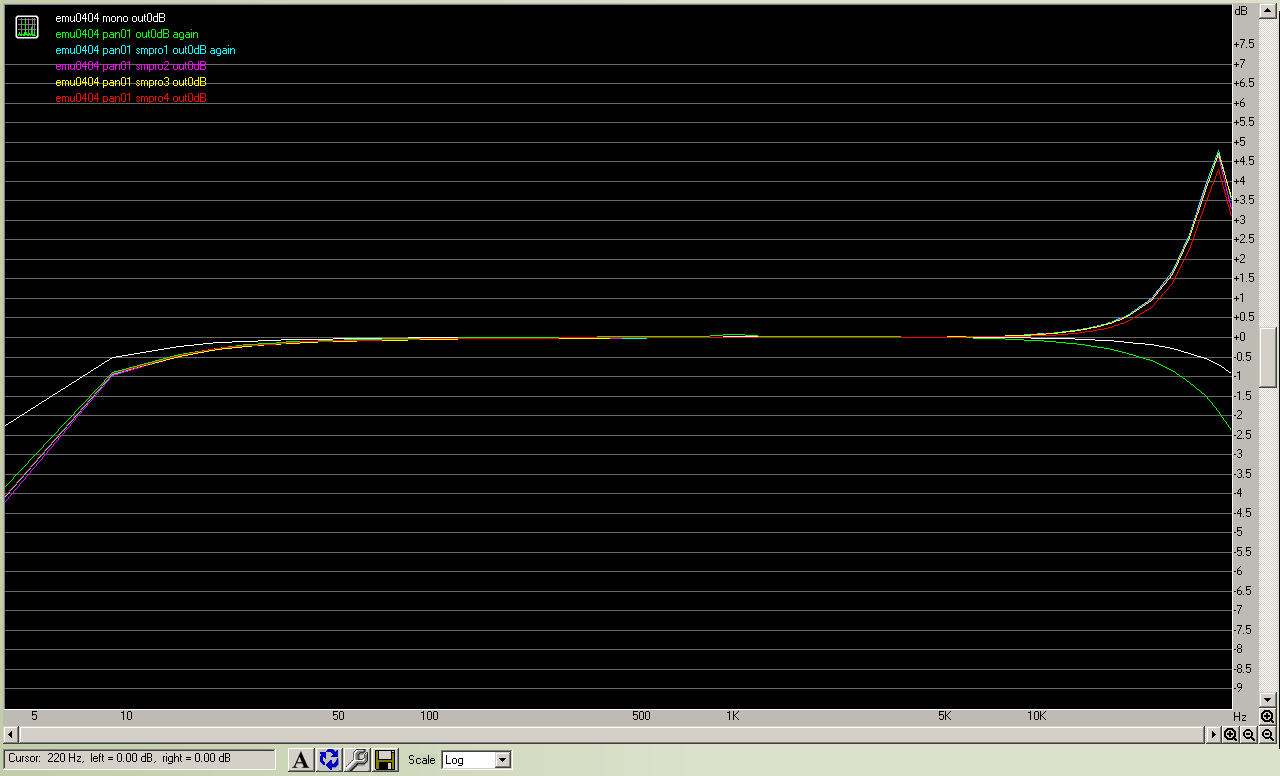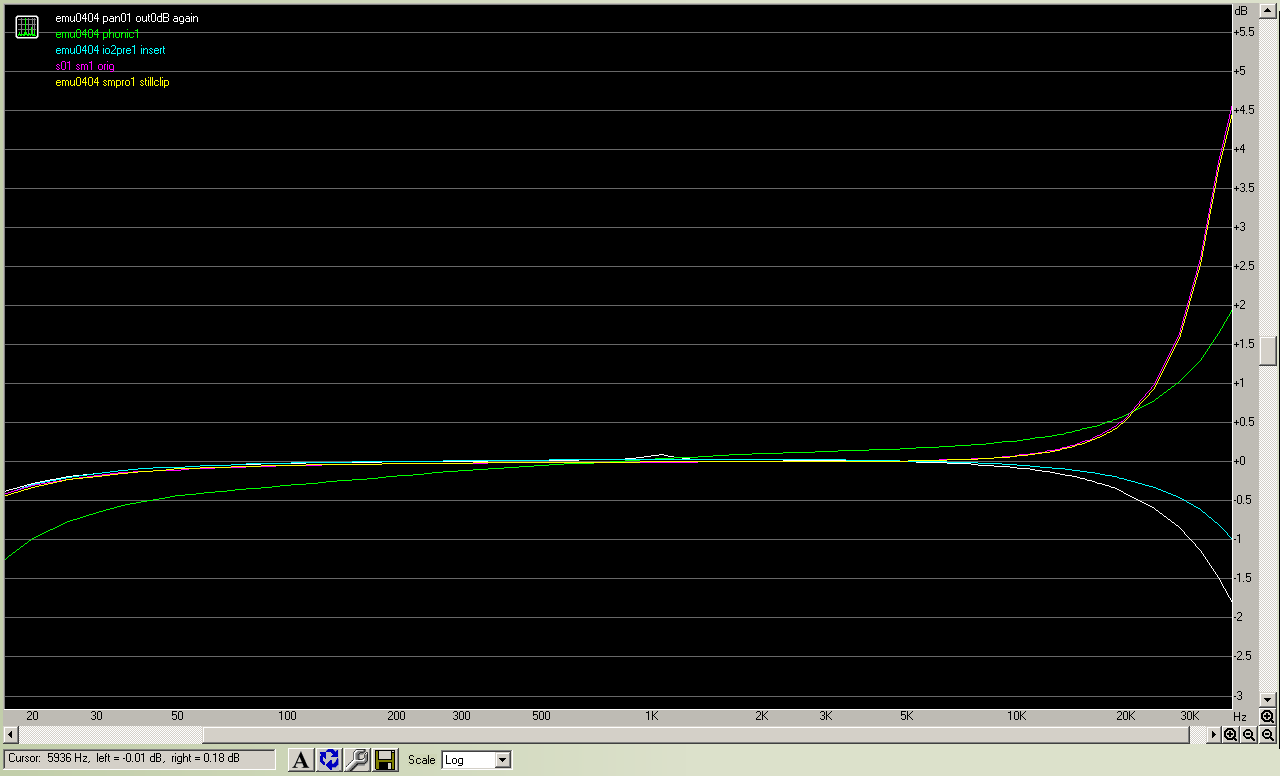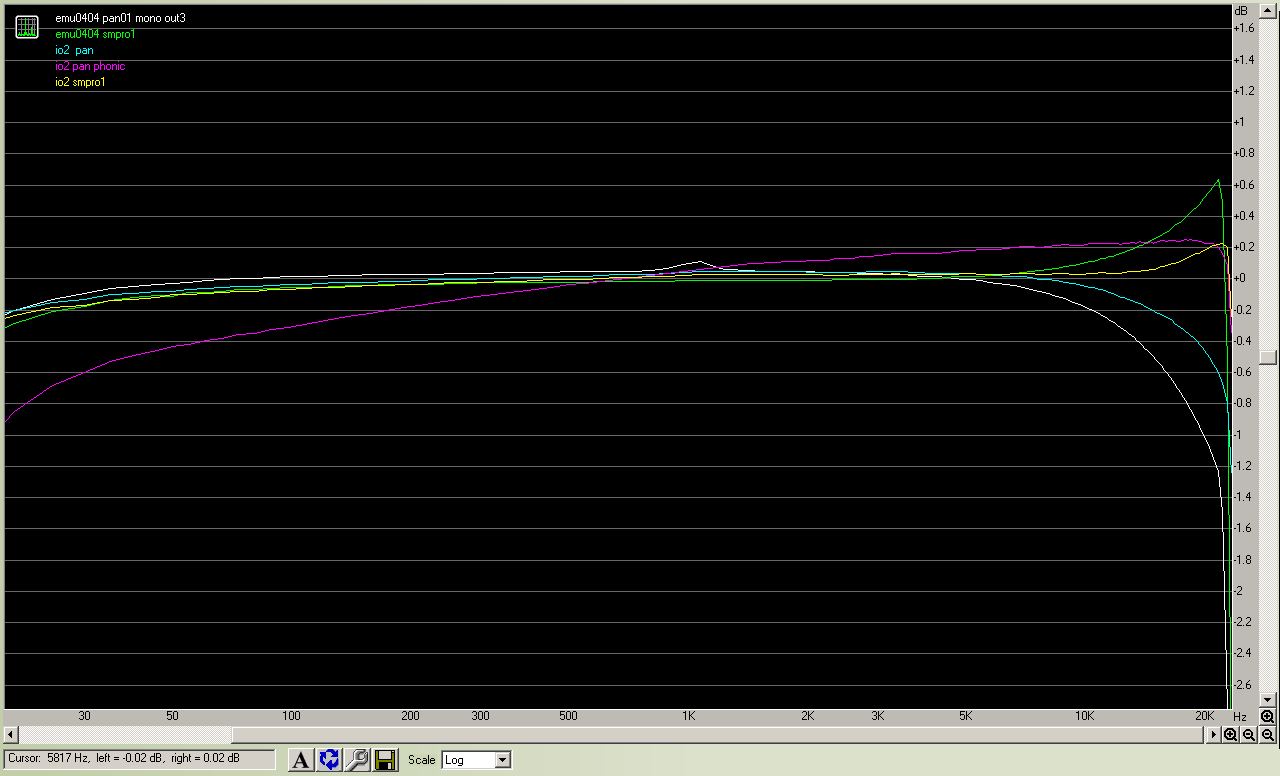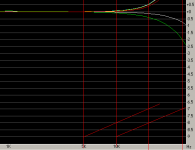Please excuse if this is totally obvious, but, well, I have this preamp lying around, a basic SMPro PR4V unit. I thought about toying with it after reading that folks are happy with exchanging opamps in a similar box (I'm new to this kind of thing and I am not yet convinced that this does make any sense). Now, apart from any subtleties that differing opamps would bring, I have a very strange frequency response of this thing, on all 4 channels:

I wired it to the output of an E-MU 0404 USB via a passive DI (which is pretty damn flat, and for sure not boosting anything), and the line back to the E-MU, running RMAA. The first measurements are the same with using the mic inputs on the E-MU instead of the SMPro. Sampling rate is 96 kHz (I actually intended to whitness the roll-off at higher-than-hearing frequencies). Now, I understand the curves for the E-MU preamp: A flat region, and then loss of signal in the lows and highs. But the SMPro thing starts to scream from 10 KHz on.
Is this a design feature to make the sound more "bright". I somehow doubt that. Do you folks know what kind of defect in a typical preamp (input/output JRC NJM4558 with a host of resistors and coupling caps) could cause this? Is this already some funny oscillation of the unmodified unit? While I am not too experienced with audio / electronics engineering, I do know my physics and math, so you can talk dirty to me;-)
I'm prepared to replace caps and resistors just to see what happens to noise level .. but I am wary of this being totally wasted with this non-linear frequency response.

I wired it to the output of an E-MU 0404 USB via a passive DI (which is pretty damn flat, and for sure not boosting anything), and the line back to the E-MU, running RMAA. The first measurements are the same with using the mic inputs on the E-MU instead of the SMPro. Sampling rate is 96 kHz (I actually intended to whitness the roll-off at higher-than-hearing frequencies). Now, I understand the curves for the E-MU preamp: A flat region, and then loss of signal in the lows and highs. But the SMPro thing starts to scream from 10 KHz on.
Is this a design feature to make the sound more "bright". I somehow doubt that. Do you folks know what kind of defect in a typical preamp (input/output JRC NJM4558 with a host of resistors and coupling caps) could cause this? Is this already some funny oscillation of the unmodified unit? While I am not too experienced with audio / electronics engineering, I do know my physics and math, so you can talk dirty to me;-)
I'm prepared to replace caps and resistors just to see what happens to noise level .. but I am wary of this being totally wasted with this non-linear frequency response.
Hm, perhaps I would get more response if the thread would be in the correct section: I meant to put it into Analog Line Level, not Digital.
Followup anyway: Considering that this may indeed be a designed property of the circuit, as I saw not so drastic but still present boosting of heights in a consumer DAC, too (wondering if it's the same as with cheap mics that pretend to sound more "crisp"), I figured that I could just try to dampen that unwanted part by putting a simple RC lowpass into the audio path.
Is that a very bad idea for some reason? And still, didn't anyone see such strange response spectrum before?
Followup anyway: Considering that this may indeed be a designed property of the circuit, as I saw not so drastic but still present boosting of heights in a consumer DAC, too (wondering if it's the same as with cheap mics that pretend to sound more "crisp"), I figured that I could just try to dampen that unwanted part by putting a simple RC lowpass into the audio path.
Is that a very bad idea for some reason? And still, didn't anyone see such strange response spectrum before?
I'm not familiar with any of that equipment but I'll venture a couple of comments anyway....
First a bit of perspective: it's not exactly "screaming" above 10KHz - the curves are only about half a decibel up at 20 KHz. In fact the green (good) curve has almost exactly the same amount of error below 20KHz as the red (bad) curve - the one is up as much as the other is down.
The sharp peak at about 40KHz suggests that it's actually a high order low pass filter. My guess is it's an anti-aliasing filter that's a bit out of alignment. The corner frequency is about right for an anti-aliasing filter for 96KHz recording.
Not that I'd normally expect an anti-aliasing filter in a mic pre-amp, but the advertising for the PR4v does say it's "specifically designed" for "digital recording".

P.S. In the pic below I tried to guesstimate vertical markers at 5, 10, 20 and 40KHz.
First a bit of perspective: it's not exactly "screaming" above 10KHz - the curves are only about half a decibel up at 20 KHz. In fact the green (good) curve has almost exactly the same amount of error below 20KHz as the red (bad) curve - the one is up as much as the other is down.
The sharp peak at about 40KHz suggests that it's actually a high order low pass filter. My guess is it's an anti-aliasing filter that's a bit out of alignment. The corner frequency is about right for an anti-aliasing filter for 96KHz recording.
Not that I'd normally expect an anti-aliasing filter in a mic pre-amp, but the advertising for the PR4v does say it's "specifically designed" for "digital recording".

P.S. In the pic below I tried to guesstimate vertical markers at 5, 10, 20 and 40KHz.
Attachments
OK, perhaps I exagerrated a bit; it's roughly 5 dB boost against 3 attenuation ... The "screaming" just relates to me really not expecting any raise of response there, a drop, rather. This peak actually makes it difficult to measure the spectrum at all (since reference level is chosen at 1 kHz).
Screaming aside, I agree that the falling slope after the peak should come from D/A filtering. That is happening inside the E-MU 0404 USB; I expect it to do something there with signals that threaten to approach 48 kHz.
So, here, I must assume that the input signal does not have that falling slope, but rather continues to rise further into higher frequs.
Perhaps I can do a measurement in 192 kHz to see if the input signal drops by itself before 96 KHz. The PR4V is designed for digital recording just in the sense that it produces line level output that you could stick up your favourite sound card input;-) The box does only analog signal processing, the ICs being 2 opamps per channel.
So ... of course, there could be a filter in the preamp that is supposed to take out those high freqs but is detuned. My question is if this would be a normal thing; having to dampen response in the high freqs in the design. Freak resonance? It is not part of the background noise of the thing, that has max levels at lower freqs.
Screaming aside, I agree that the falling slope after the peak should come from D/A filtering. That is happening inside the E-MU 0404 USB; I expect it to do something there with signals that threaten to approach 48 kHz.
So, here, I must assume that the input signal does not have that falling slope, but rather continues to rise further into higher frequs.
Perhaps I can do a measurement in 192 kHz to see if the input signal drops by itself before 96 KHz. The PR4V is designed for digital recording just in the sense that it produces line level output that you could stick up your favourite sound card input;-) The box does only analog signal processing, the ICs being 2 opamps per channel.
So ... of course, there could be a filter in the preamp that is supposed to take out those high freqs but is detuned. My question is if this would be a normal thing; having to dampen response in the high freqs in the design. Freak resonance? It is not part of the background noise of the thing, that has max levels at lower freqs.
The interesting thing is that the green and white curves don't have the same sharp corner followed by a rapid drop, so they weren't subject to the same filtering.Screaming aside, I agree that the falling slope after the peak should come from D/A filtering. That is happening inside the E-MU 0404 USB...
As I understand it, those curves were measured with the signal going into the mic input of the E-MU, whereas the other curves were measured with the signal going via the PR4V to the line input of the E-MU 0404.
If that's the case, maybe the E-MU only filters the line input, not the mic input. I'm starting to think the E-MU is to blame for the weird response, not the PR4V.
OK, no crazy filters in there then.The PR4V is designed for digital recording just in the sense that it produces line level output that you could stick up your favourite sound card input;-) The box does only analog signal processing, the ICs being 2 opamps per channel.
If that's the case, maybe the E-MU only filters the line input, not the mic input. I'm starting to think the E-MU is to blame for the weird response, not the PR4V.
Well, or you don't see a sudden drop because there is no raise before. Don't you think that the filter might act more drastic on up-sloping response than on down-sloping? I'm wary of judging the position of the last measurement point at the digital frequency limit. It's funny how you focus on this point, while I quickly dismissed it as unrelated. That's why you put up those questions to a forum. But I still think your hypothesis is wrong.
I do have another audio interface that can also act as analog preamp via direct monitoring, and in the end, there's also small mixer I could try. Yes, I'm going to do a measurement of the mic input of that one. And I can repeat the measuremens with another interface, albeit at 48 kHz. But what I can already say is that measuing the E-MU line-out to line-in, there is no raise at all towards the high end. Putting the preamp in between produces that increase in response to begin with.
All in all, at least you do agree that this spectrum is not normal, right?
(Note: Might be double post, becaue I am not sure if last night's posting really left my computer.)
OK, then. I did some measurement on the cheap mixer (Phonic, if that name rings a bell ...), mic input to master output. Then, I also hooked the preamp of my other interface, the Alesis io|2 into the chain. It is really handy that this box has an insert path to get the signal directly from the preamp. If I take the signal from the monitoring path, I see nicely that there has been a filter cutting things to prepare for 48 kHz sampling (I still think the path is analog, not sure, though). Anyhow, from the insert it just behaves like a normal analog preamp.
I have two plots, one at 96 kHz and one at 48 kHz (sadly, it is late and I did not re-do every emu0404 measurement with 48; io|2 can only work at 48, but some cross-checking is doable). The word "pan" or "pan01" refers to the DI box to make it clear hat I am recording with a microphone input; it's left out where it is clear from context that it is in use (when mentioning the preamp). Basically: All measurements here involve the microphone input of some device.


Now, what do we see? At first, it is apparent that the Phonic mixer also puts out strong heights, but not as strong as the SMPro. So that basic property seems to be shared in those budget devices! But using the analog preamp section of the io|2, you see a response like I expected: smooth, slowly falling. When recording not from the insert but the monitor output of the io|2, one sees nicely the smooth but determined filter to weed out things over 24 kHz, since the A/D of that box cannot take more.
You might notice that the peak is gone: I excluded it from the view of the spectrum, simply because it really is an artifact: RMAA always complains about one point clipping, unless I really turn down the gain, where it complains that the signal is too weak to analyze. I believe this falling slope is simply this one point that is distorted because of too high gain (measurements needs adequate volume at 1 kHz and below, which is more quiet than >40 kHz). So please, let's not linger on that point, only the fact that the level there is problematic with the SMPro.
Now, comparing the picture in 48 kHz sampling rate, one does see that both audio interfaces confirm the raising response in the high end of the SMPro, but to a differing extend: The io|2 has clearly a stronger filter in place. probably because the whole unit is optimized to work with 48 kHz sampling rate. The E-MU 0404 can go up to 192 kHz (just 96 in full duplex, though), so the filtering is generally letting more through.
So, it looks like it is just the way of those (not too expensive, after all) preamps to give some boosting in the high frequencies, while the more moderate preamps in my interfaces behave as expected. Makes me think a bit ... the SMPro with 4 channels did cost about 100 or 150 EUR (not sure anymore) and it is nothing more than a preamp. The io|2 is just 100 EUR, has 2 better preamps and offers A/D D/A to USB to boot. Plus instrument input, headphone output, yadda, yadda. Seems to be better value to buy recording interfaces with builtin preamps, after all (I was pondering the Echo AudioFire 12, which has 12 line inputs to be paired with some external mic preamps). Of course, unless you intend to purchase/have more high-end preamps to begin with.
So, one solution would be to just not record at more than 48 kHz or ignore the increased response above hearing (that frequency headroom at 96 kHz is only of use to stuff noise/distortion from digital filters there, anyway). Another would be to still modify the preamp to show a normal respone, not boosting things unwanted. I guess I will try that and see if I get a more linear preamp.
The other new issue is that I realized that my little mixer suffers from that, too, but to a lower degree. And: This thing has EQ anyway, so I know that for neutral sound, I should turn the treble a bit down and bass a bit up. And buy more expensive speakers for that one.

Anything to add to this manifest of mine? One has to be careful, letting me get in range of a keyboard at night.

Though, I still am interested in response curves from other people's preamps. Perhaps one step up in the price ladder from the SMPros. And of course some high-enders, or DIY (which can be on either end regardless of cost
 ). Don't you DIY folks have such curves at hand? Hooking up the freeware RMAA with a DI box shouldn't be that hard (I managed to do it without even having Windows installed). And it's fun to get some data!
). Don't you DIY folks have such curves at hand? Hooking up the freeware RMAA with a DI box shouldn't be that hard (I managed to do it without even having Windows installed). And it's fun to get some data!
.
I do have another audio interface that can also act as analog preamp via direct monitoring, and in the end, there's also small mixer I could try. Yes, I'm going to do a measurement of the mic input of that one.
OK, then. I did some measurement on the cheap mixer (Phonic, if that name rings a bell ...), mic input to master output. Then, I also hooked the preamp of my other interface, the Alesis io|2 into the chain. It is really handy that this box has an insert path to get the signal directly from the preamp. If I take the signal from the monitoring path, I see nicely that there has been a filter cutting things to prepare for 48 kHz sampling (I still think the path is analog, not sure, though). Anyhow, from the insert it just behaves like a normal analog preamp.
I have two plots, one at 96 kHz and one at 48 kHz (sadly, it is late and I did not re-do every emu0404 measurement with 48; io|2 can only work at 48, but some cross-checking is doable). The word "pan" or "pan01" refers to the DI box to make it clear hat I am recording with a microphone input; it's left out where it is clear from context that it is in use (when mentioning the preamp). Basically: All measurements here involve the microphone input of some device.


Now, what do we see? At first, it is apparent that the Phonic mixer also puts out strong heights, but not as strong as the SMPro. So that basic property seems to be shared in those budget devices! But using the analog preamp section of the io|2, you see a response like I expected: smooth, slowly falling. When recording not from the insert but the monitor output of the io|2, one sees nicely the smooth but determined filter to weed out things over 24 kHz, since the A/D of that box cannot take more.
You might notice that the peak is gone: I excluded it from the view of the spectrum, simply because it really is an artifact: RMAA always complains about one point clipping, unless I really turn down the gain, where it complains that the signal is too weak to analyze. I believe this falling slope is simply this one point that is distorted because of too high gain (measurements needs adequate volume at 1 kHz and below, which is more quiet than >40 kHz). So please, let's not linger on that point, only the fact that the level there is problematic with the SMPro.
Now, comparing the picture in 48 kHz sampling rate, one does see that both audio interfaces confirm the raising response in the high end of the SMPro, but to a differing extend: The io|2 has clearly a stronger filter in place. probably because the whole unit is optimized to work with 48 kHz sampling rate. The E-MU 0404 can go up to 192 kHz (just 96 in full duplex, though), so the filtering is generally letting more through.
So, it looks like it is just the way of those (not too expensive, after all) preamps to give some boosting in the high frequencies, while the more moderate preamps in my interfaces behave as expected. Makes me think a bit ... the SMPro with 4 channels did cost about 100 or 150 EUR (not sure anymore) and it is nothing more than a preamp. The io|2 is just 100 EUR, has 2 better preamps and offers A/D D/A to USB to boot. Plus instrument input, headphone output, yadda, yadda. Seems to be better value to buy recording interfaces with builtin preamps, after all (I was pondering the Echo AudioFire 12, which has 12 line inputs to be paired with some external mic preamps). Of course, unless you intend to purchase/have more high-end preamps to begin with.
So, one solution would be to just not record at more than 48 kHz or ignore the increased response above hearing (that frequency headroom at 96 kHz is only of use to stuff noise/distortion from digital filters there, anyway). Another would be to still modify the preamp to show a normal respone, not boosting things unwanted. I guess I will try that and see if I get a more linear preamp.
The other new issue is that I realized that my little mixer suffers from that, too, but to a lower degree. And: This thing has EQ anyway, so I know that for neutral sound, I should turn the treble a bit down and bass a bit up. And buy more expensive speakers for that one.
Anything to add to this manifest of mine? One has to be careful, letting me get in range of a keyboard at night.
Though, I still am interested in response curves from other people's preamps. Perhaps one step up in the price ladder from the SMPros. And of course some high-enders, or DIY (which can be on either end regardless of cost
.
- Status
- This old topic is closed. If you want to reopen this topic, contact a moderator using the "Report Post" button.
- Home
- Source & Line
- Analog Line Level
- Mic pre strange high-freq boost (what is broken here?)

